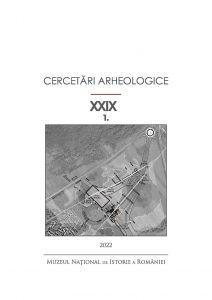Multi-analytical study of the archaeological leather discovered near the medieval Oratea fortress
Multi-analytical study of the archaeological leather discovered near the medieval Oratea fortress
Author(s): Cristina Carsote, Elena Badea, Eugen S. TeodorSubject(s): Archaeology, Ancient World
Published by: MUZEUL NAȚIONAL DE ISTORIE A ROMÂNIEI
Keywords: archaeological leather; FTIR-ATR; micro DSC; XRF; SEM; decay;
Summary/Abstract: Recent archaeological excavations made on the plateau located east of the medieval fortress at Oratea (Podu Dâmboviţei, Argeş County) evidenced a fortified position of the Roman Age. Among other finds there is a relatively large leather fragment, belonging to the earliest phase (beginning of the second century AD). This discovery is extremely rare since suitable preservation conditions for leather are rarely meet in the specific soil and climate conditions in Romania. The contact with atmosphere induced sudden dehydration and consequent fragmentation of leather, which required a multi-analytical approach to extract useful information about its degradation condition. A combination of molecular (Fourier transform infrared spectroscopy in attenuated total refection mode, FTIR-ATR) and elemental (X-ray fluorescence, XRF) spectroscopic techniques with micro differential scanning calorimetry (micro-DSC) and scanning electron microscopy (SEM) was applied to this purpose. FTIR-ATR analysis allowed us to detect gelatin on the samples’ surface based on the collagen spectral components. Collagen extended de-tanning, gelatinisation and conversion into amorphous structures was quantified by micro- DSC. The alterations of leather microstructure and morphology were observed by high magnification SEM. XRF analysis also provided the elemental composition of soil. Overall, the archaeological samples shown extremely high fragility and the tendency to turn into powder on drying. This behaviour is due to the gelatinous-amorphous structure of leather strengthened only by the mineral components of the soil. Given the extremely high risk of loss, the authors recommend the application of a consolidation method based on halloysite and other nanoclays incorporation with utmost urgency.
Journal: Cercetări Arheologice
- Issue Year: XXIX/2022
- Issue No: 1
- Page Range: 185-196
- Page Count: 12
- Language: English

